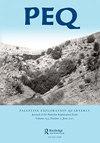Dating the Fortress of Umm Tawabin, Jordan: Results of Radiocarbon Dating Analysis
IF 0.8
2区 历史学
0 ARCHAEOLOGY
引用次数: 0
Abstract
Umm Tawabin is a large fortress (elevation 200 b.m.l.) strategically situated on top of a mountain overlooking the northern Wadi ʿArabah in Jordan. The site comprises a citadel with the remains of a fort (Fort A), as well as three collapsed stone buildings (Forts B–D), over one hundred circular stone enclosures, a dam, road and quarry all spread across an area 880 by 450 m in size that is fortified by a 2.5 km long casemate wall. Umm Tawabin had not been fully investigated since it was discovered in the late 19th century by a Palestine Exploration Fund (PEF) expedition (Abujaber and Cobbing 2005, 36–38, Hart 1885, 266, Hull 1889, 121, Kitchener 1883, 216–17) until the Ghor as-Safi Project survey (Ariotti 2017) and excavations (Ariotti 2021; Politis and Ariotti 2020), co-sponsored by the PEF and with permission from the Jordanian Department of Antiquities (DoAJ excavation permits 2015/1, 2017/1 and 2018/1) that have addressed questions concerning the extent, function (or multiple functions) and dating of the site for the first time.约旦乌姆塔瓦宾要塞的年代测定:放射性碳测年分析的结果
乌姆·塔瓦宾是一座大型堡垒(海拔200英尺),战略性地坐落在一座山顶上,俯瞰约旦北部的瓦迪·阿拉伯河。该遗址包括一个堡垒遗迹(堡垒a)的城堡,以及三个倒塌的石头建筑(堡垒B-D),一百多个圆形石头围墙,一个水坝,道路和采石场,所有这些都分布在面积为880米× 450米的区域,由2.5公里长的围墙加固。乌姆塔瓦宾自19世纪末由巴勒斯坦勘探基金(PEF)探险队(Abujaber and Cobbing 2005, 36-38, Hart 1885, 266, Hull 1889, 121, Kitchener 1883, 216-17)发现以来,一直没有得到充分的调查,直到Ghor as-Safi项目的调查(Ariotti 2017)和挖掘(Ariotti 2021;Politis和Ariotti 2020),由PEF共同赞助,并获得约旦古物部的许可(DoAJ挖掘许可2015/1、2017/1和2018/1),首次解决了有关该遗址的范围、功能(或多种功能)和年代的问题。
本文章由计算机程序翻译,如有差异,请以英文原文为准。
求助全文
约1分钟内获得全文
求助全文

 求助内容:
求助内容: 应助结果提醒方式:
应助结果提醒方式:


